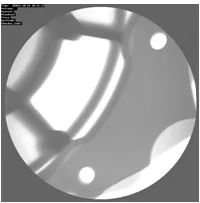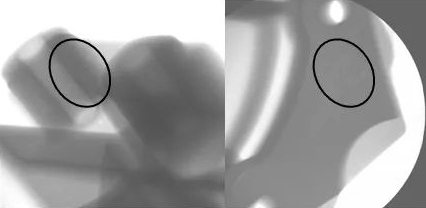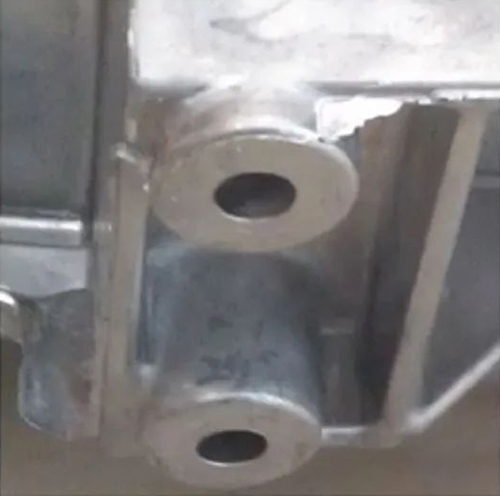Using the working principle of the mechanical vacuum valve, combined with the quality and performance requirements of aluminum alloy castings, different vacuuming processes are formulated for testing, and the correlation between the internal quality of aluminum alloy die castings and the vacuum process is studied by X-ray. At the same time, the influence of mechanical vacuum valve failure on the product is studied.
With the development of science and technology, automobile lightweight is one of the most effective means to save energy and improve fuel economy. Replacing steel with aluminum is an important direction for the development of automobiles. Die casting is one of the most important methods for forming aluminum alloy parts, and how to give full play to technical advantages, improve production efficiency and reduce costs is an important direction for the future development of the die casting industry. The application of high vacuum die casting technology reduces the porosity of aluminum alloy die castings, improves the internal quality of the castings, and improves the body hardness of the castings and the mechanical properties of the castings, which has attracted the attention of die casting enterprises.
Vacuum die casting is generally divided into quench exhaust groove method (Mass venting method) and mechanical vacuum valve method. This subject is aimed at the aluminum alloy die-casting of automobile gearbox casing, and introduces the vacuuming process to improve the internal and external quality of the product. Research the application of mechanical vacuum valve method vacuuming technology in die casting, verify the vacuuming effect by verifying different vacuum degrees and adopting different vacuuming methods, in order to find the best technological means to improve product quality.
1 Mechanical vacuum valve method cavity vacuum test
This test is to improve the internal quality of a gearbox casing. Before the vacuum process was adopted, the X-ray of the product showed that there were local pores, especially the thickness of the water tail wall, so try to use the vacuum process to improve the internal quality of the product. Use Lijin 16 000kN die-casting machine, select NHVDC-S type high vacuum control system, and use hydraulic mechanical vacuum valve method to evacuate. In the first test, only the cavity is evacuated. The simple principle is shown in Figure 1.

Figure 1 Schematic diagram of the mechanical cavity vacuuming principle
Before the injection, the vacuum hydraulic station stores energy, and the vacuum valve is closed. When the injection starts, the vacuum control system will check the position information of the injection rod by contacting the encoder. When the opening position X1 of the vacuum valve is set by setting , the vacuum valve will be opened, and the vacuum valve core will be opened at the same time (controlled by the hydraulic station). When the closing position is X3, the hydraulic station receives the closing signal, closes the valve core, and the vacuum machine also closes the vacuum valve of the vacuum machine at the same time to complete the vacuuming action. When the mold is opened, the hydraulic station controls the valve core of the vacuum valve of the mold to open, the compressed air valve of the vacuum machine is opened, and the air flow passes through the pipeline to blow off the aluminum scraps and fronts in and around the valve core, so as to ensure that the vacuum valve can work smoothly in the next cycle.
A total of 8 sets of tests with different process conditions were set. Under the condition of vacuum degree of -70 kPa, when the opening position X1 of the vacuum valve was set as a, the closing vacuum position X3 was 300, 400, 500, 600 mm respectively. Verification (According to experience, the general maximum value is less than the set value of the second position of the injection, the purpose is to prevent the valve core from entering the material). Increase the vacuum to -90 kPa, and the X3 position is also tested at 300, 400, 500, 600 mm. Mark the products of each group of tests, and use the X-ray machine for flaw detection to verify the internal quality of the products (porosity distribution).
(1) After the product is evacuated, the surface gloss of the product becomes higher, and the cold insulation is significantly reduced. X-ray detection shows that the internal structure of the vacuumed product is denser, indicating that the vacuum process can effectively improve the internal quality of the product. Figures 2 and 3 are the appearance and partial X-ray pictures of the casting in the non-vacuum die casting process, and Figures 4 and 5 are the appearance and partial X-ray pictures of the casting in the vacuum die casting process.

Figure 2 The overall appearance of the casting (non-vacuum)

Figure 3 Partial X-ray (non-vacuum)

Figure 4 Overall appearance of casting (vacuum)

Figure 5 Partial X-ray (vacuum)
(2) Set different vacuuming parameters, mark each group of samples, and perform X-ray flaw detection. It was found that by increasing the vacuuming distance (or prolonging the vacuuming time as much as possible), the internal pores of the casting showed signs of reduction, which could make the internal quality of the casting more dense. Improving the vacuum degree of the cavity (vacuum machine vacuum degree) can make the vacuuming effect better, which is more conducive to reducing the generation of pores in the casting and improving the internal quality of the casting. Figures 6 and 7 are X-ray pictures of different vacuum degrees and the position where the vacuum is stopped.

Fig.6 Partial X-ray images of different positions of vacuum stop when the vacuum degree is -70 kPa

Fig.7 Partial X-ray images of different positions of vacuum stop when the vacuum degree is -90 kPa
2 Mechanical vacuum valve method to vacuum the cavity and pressure chamber at the same time
The results of the first test show that properly extending the vacuuming distance or increasing the vacuum degree of the cavity can effectively reduce the generation of pores in the casting and improve the quality of the product.
In the second test, a vacuum hole was opened in the middle of the trough, and vacuum was added to the pressure chamber. The principle of introducing a vacuum in the pressure chamber is basically the same as that of Test 1. The main difference is that the cavity is evacuated while increasing the vacuum in the pressure chamber, first the pressure chamber is evacuated, and then the cavity vacuum channel is closed after closing the pressure chamber, and finally the vacuum is completed.
The process parameter setting conditions of the second test are the same as those of the first test, and the vacuum degree is set to -90 kPa. From the X-ray inspection of the second test, it is known that the vacuuming process of the trough is introduced, and the quality of the internal pores of the casting is better than that of the first test, as shown in Figures 8 and 9. At the same time, the appearance of the casting is compared. After the vacuum is introduced into the pressure chamber, the casting has a better appearance than the original, and the appearance of the cold flow marks and other appearances has been improved significantly, as shown in Figure 10 and Figure 11.

Figure 8 X-ray photo of vacuumless casting casting

Figure 9 X-ray photo of vacuumed casting with pressure chamber

Figure 10 Appearance of the column evacuated from the pressureless chamber

Figure 11 Appearance of the column with vacuum chamber
3 The importance of maintenance of mechanical vacuum valve
In addition to the reasonable setting of the vacuuming time and the vacuum degree of the cavity, which are very important to the product quality, the failure of the mechanical vacuum valve is also a very critical factor affecting the product quality. If the vacuum valve fails, the vacuuming time and The degree of vacuum cannot be guaranteed, which has a significant impact on the quality of the product. Therefore, how to check and maintain the vacuum valve is very important.
According to the summary of production experience, the maintenance process of the vacuum valve is roughly as follows: ①Clip the adjustable wrench on the valve body flat, hold the tail of the adjustable wrench firmly with both hands, remove the valve body in a counterclockwise direction, open the cover and take out the dirty Steel ball, blow clean the inside of the valve body with an air gun, and then replace it with a new steel ball. The replacement frequency of the steel ball is every 2 days; ② Press the water pipe joint chuck to pull out the water pipe, and press the cylinder fixing rod screw counterclockwise. Take it out, hold the oil tube of the oil cylinder with both hands, shake it gently and pull it out, remove the oil cylinder, and visually check whether the connecting block hanging table is worn, if there is wear, a new connecting block must be replaced (when replacing a new connecting block, it is used for locking The screws of the connecting block must be coated with a screw fixative); ③ Disassemble the valve seat pressure plate screws, and screw the two pullers clockwise into the pressure plate screw holes. Pull the puller with both hands at the same time, remove the valve seat pressure plate, take out the vacuum valve core and valve seat, visually check whether the valve stem is pulled, worn or bent at each position, and replace it. Remove the screw at the bottom of the valve seat, take out the valve seat guide sleeve, check whether the guide sleeve is worn or aged, and replace it. It is required to replace the guide sleeve and valve stem every 25,000 pieces of products produced; ④ Visually check whether the valve stem is pulled in various positions. , worn or bent, and must be replaced when the above problems occur. Before replacing the valve stem, it is necessary to check whether the matching gap between the valve stem and the valve seat meets the requirements of the drawing by means of mold matching, and then replace it after confirming that it is qualified; Activate the control button of the hydraulic station, push out the valve stem, use the height gauge to measure the height of the valve stem when it is ejected (0.2 mm higher than the parting surface), return the valve stem, and use the height gauge to measure the height of the valve stem when it is ejected (below the minute Profile 9.2 mm), the standard length of the valve stem is as follows: the active stroke of the valve stem is 0.5~1 mm shorter than the cylinder stroke, and the active stroke of the valve stem is 9~9.5 mm. Close the control button of the hydraulic station and squeeze the valve stem head firmly with both hands Front and rear activities. If the valve stem can move back and forth and the virtual distance exceeds 0.3 mm, the fixed die must be adjusted to check whether the thread of the connection head and the cylinder shaft is loosened, and whether the screw of the cylinder base is loosened.
4 Conclusion
The vacuum casting process can effectively reduce the pores of the casting, which can make the internal quality of the casting more dense, and the appearance quality of the product can also be improved; under suitable conditions, increasing the vacuuming time of the cavity, the internal quality of the casting can be improved. A good improvement is proportional to the vacuuming time; improving the vacuum capacity in the cavity (the lower the vacuum, the better), can produce higher quality castings; under suitable conditions, increase the vacuuming of the pressure chamber to make The effect of vacuuming is better, and it can also improve the internal and external quality of the casting as a whole; the perfect maintenance of the mechanical vacuum valve plays a vital role in the quality of the product.

地址:浙江省宁波市北仑区大碶沿塘河路6号
孙跃君:13806631860
王式雍:15958891460 / 15058297768
电话:0574-86140828 / 0574-86140818
传真:0574-86140828